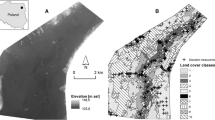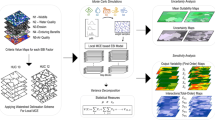Abstract
Habitat suitability index (HSI) models have been generally accepted in ecological management as a means to predict effects of pressures and restoration measures on habitats and populations. HSI-models estimate habitat suitability from relevant habitat variables. Because outcomes of HSI-studies may have significant consequences, it is crucial to have insight into the uncertainties of the predictions. In this study a method for uncertainty analysis, using Monte Carlo simulations, was developed and applied for a HSI-model of pondweed (Potamogeton pectinatus) in Lake IJsselmeer, The Netherlands. Uncertainties in both habitat model functions and in input data were considered. The magnitude of the uncertainties in model functions were estimated by a panel of experts, and the uncertainty was highest at intermediate values of the suitability index (0.4–0.6). Uncertainty in the predicted habitat suitability is spatially correlated with variations in environmental habitat variables such as water quality and substrate. The estimated uncertainty may be considered acceptable for the purposes of water management, namely directing ecological rehabilitation and conservation activities. However, the uncertainties may be too high to meet the accuracy requirements of legislation such as the EU Bird and Habitat directive.
Similar content being viewed by others
References
L.C. Bender G.J. Roloff J.B. Haufler (1996) ArticleTitleEvaluating confidence intervals for habitat suitability models Wildlife Soc. Bull. 24 347–352
T.S. Beutel R.J.S. Beeton G.S. Baxter (1999) ArticleTitleBuilding better wildlife-habitat models Ecography 22 219–223 Occurrence Handle10.1111/j.1600-0587.1999.tb00471.x
W.M. Block M.L. Morrison J. Verner P.N. Manley (1994) ArticleTitleAssessing wildlife–habitat–relationships models: a case study with California oak woodlands Wildlife Soc. Bull. 22 549–561
R.P. Brooks (1997) ArticleTitleImproving habitat suitability index models Wildlife Soc. Bull. 25 163–167
M.A. Burgman D.R. Breininger B.W. Duncan S. Ferson (2001) ArticleTitleSetting reliability bounds on habitat suitability indices Ecol. Appl. 11 70–78
C. Caroll W.J. Zielinski R.F. Noss (1999) ArticleTitleUsing presence–absence data to build and test spatial habitat models for the fisher in the Klamath region, USA Conserv. Biol. 13 1344–1359 Occurrence Handle10.1046/j.1523-1739.1999.98364.x
Cooke R.M. 1991. Experts in Uncertainty. Oxford University Press, ISBN 0-19-506465-8
R. Dettmers D.A. Buehler K.E. Franzreb (2002) ArticleTitleTesting habitat-relationship models for forest birds of the southeastern United States J. Wildlife Manage. 66 417–424
H. Duel B. Pedroli W.E.M. Laane (1996) The habitat evaluation procedure in the policy analysis of inland waters in the Netherlands: towards ecological rehabilitation M. Leclerc H. Carpa S. Valentin A. Boureault Y. Cote (Eds) Ecohydraulics 2000 2nd International Symposium on Habitat Hydraulics Quebec 619–630
InstitutionalAuthorNameEuropean Commission (2000) Managing Natura 2000 sites: The Provisions of Article 6 of the ‘Habitats ’Directive 92/43/EEC Office for Official Publications of the European Communities Luxembourg 69 pp.
Frijters M. 1999. Expertmeningen. Bouwdienst Rijkswaterstaat. Rapport EXM-R-9800X.
J.A. Gore S.W. Hamilton (1996) ArticleTitleComparison of flow-related habitat evaluations downstream of low-head weirs on small and large fluvial ecosystems Regulated Rivers Res. Manage. 12 459–469 Occurrence Handle10.1002/(SICI)1099-1646(199607)12:4/5<459::AID-RRR413>3.0.CO;2-T
A. Guisan N.E. Zimmermann (2000) ArticleTitlePredictive habitat distribution models in ecology Ecol. Model. 135 147–186 Occurrence Handle10.1016/S0304-3800(00)00354-9
J.M. Hammersley D.C. Handscomb (1979) Monte Carlo Methods Chapman and Hall London
J.F. Hurley (1986) Summary: developmenttesting, and application of wildlife-habitat models – the manager′s viewpoint J. Verner M.L. Morrison C.J. Ralph (Eds) Modeling Habitat Relationships of Terrestrial Vertebrates Univ. Wisconsin Press Madison 151–154
L. Jans (1997) Inventarisatie en toepassing van ecologische modellen. Definitiestudie instrumentarium waterhuishouding in het natte hart Werkdocument 97.045X RIZA
W.E.M. Laane (1996) Habitatmodellen waterplanten Gele Plomp, Rivierfonteinkruidschedefonteinkruid en watergentiaan Werkdocument 96.049X TNO-BSA
P.A.W. Lewis E.J. Orav (1989) Simulation Methodology for Statisticians, Operation Analysts and Engineers, I Wadsworth & Brooks/Cole Pacific Grove
I. Maddock (1999) ArticleTitleThe importance of physical habitat assessment for evaluating river health Freshwater Biol. 41 373–391 Occurrence Handle10.1046/j.1365-2427.1999.00437.x
R. Noordhuis D.T. Molen ParticleVan der M.S. Berg ParticleVan den (2001) ArticleTitleResponse of herbivorous waterbirds to the return of Chara in Lake VeluwemeerThe Netherlands Aquatic Bot. 72 349–367 Occurrence Handle10.1016/S0304-3770(01)00210-8
P. Parasiewicz (1996) ArticleTitleEstimation of physical habitat characteristics using automation and geodesic-bases sampling Regulated Rivers Res. Manage. 12 575–583 Occurrence Handle10.1002/(SICI)1099-1646(199611)12:6<575::AID-RRR400>3.0.CO;2-K
S.F. Railsback H.B. Stauffer B.C. Harvey (2003) ArticleTitleWhat can habitat preference models tell us? Tests using a virtual trout population Ecol. Appl. 13 1580–1594
G.J. Roloff B.J. Kernohan (1999) ArticleTitleEvaluating reliability of habitat suitability index models Wildlife Soc. Bull. 27 973–985
K.D. Rothley (2001) ArticleTitleManipulativemulti-standard test of a white-tailed deer habitat suitability model J. Wildlife Manage. 65 953–963
E.J.R. Rykiel (1996) ArticleTitleTesting ecological models: the meaning of validation Ecol. Model. 90 229–244 Occurrence Handle10.1016/0304-3800(95)00152-2
InstitutionalAuthorNameUS Fish and Wildlife Service (1980) Habitat Evaluation Procedures (HEP), 101 Div. Ecol. Serv. U.S. Dep. Inter. Fish Wildl. Serv Washington, DC
US Fish and Wildlife Service 1981. Standards for the Development of Habitat Suitability Index Models. U.S. Fish and Wildlife Service, Release No. 1-81, 103 ESM.
G.E.M. Lee ParticleVan der H. Aarts H. Duel S. Groot R. Pouwels (2000) Kwaliteit van het HEP-instrumentarium voor toepassing in het IJsselmeergebied T2391, WL|Delft Hydraulics Delft
Van der Lee G.E.M., van den Boogaard H.F.P. and Penning W.E. 2003. Achtergronddocument voor aanvulling van het habitatinstrument: 1. Flexibilisering invoer; 2. Onzekerheidsanalyses; 3. Validatie. Q3433, WL|Delft Hydraulics.
P.M. Dijk ParticleVan F.J.P.M. Kwaad (1999) The Supply of Sediment to the River Rhine Drainage Network. The Impact of Climate and Land Use Change on Soil Erosion and Sediment Transport to Stream Channels. 99-5 ICG Amsterdam
Van Eerden M.R. 1997. Patchwork. Patch use habitat exploitation and carrying capacity for water-birds in Dutch freshwater wetlands. Van Zee tot Land 65, 448 pp.
B. Horne ParticleVan J.A. Wiens (1991) Forest Bird Habitat Suitability Models and the Development of General Habitat Models. 8 U.S. Dep. Int., Fish Wildlife Service Washington DC
M.J. Whittingham J.D. Wilson P.F. Donald (2003) ArticleTitleDo habitat association models have any generality? Predicting skylark Alauda arvensis abundance in different regions of southern England Ecography 26 521–531 Occurrence Handle10.1034/j.1600-0587.2003.03522.x
J.G. Williams (1996) ArticleTitleLoss in space: minimum confidence intervals for idealized PHABSIM studies Trans. Am. Fisheries Soc. 125 458–465 Occurrence Handle10.1577/1548-8659(1996)125<0458:LISMCI>2.3.CO;2
Author information
Authors and Affiliations
Corresponding author
Rights and permissions
About this article
Cite this article
Van der Lee, G.E.M., Van der Molen, D.T., Van den Boogaard, H.F.P. et al. Uncertainty analysis of a spatial habitat suitability model and implications for ecological management of water bodies. Landscape Ecol 21, 1019–1032 (2006). https://doi.org/10.1007/s10980-006-6587-7
Received:
Accepted:
Issue Date:
DOI: https://doi.org/10.1007/s10980-006-6587-7




